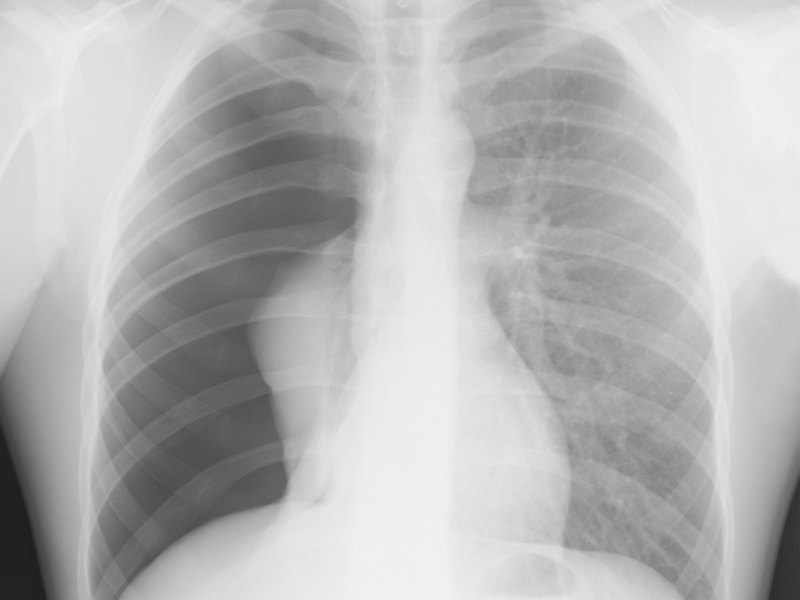Pneumothorax

Pneumothorax, often known as a collapsed lung, occurs when air escapes the lungs. The area between the lung and the chest wall is then filled with air. The accumulation of air causes pressure on the lungs. As a result, when you breathe in, it does not expand as much as it should.
This condition can be painful and, in some cases, life-threatening. If you believe you may have collapsed a lung, go to the nearest emergency department immediately.
Causes of Pneumothorax
Pneumothorax can be due to:
1. Injury
This may include:
· a rib fracture
· gunshot
· knife wound to the chest
· specific medical procedures like lung biopsy or mechanical ventilation
2. Medical conditions
Medical conditions can cause the lungs to become weak and collapse. This includes:
· Tuberculosis
· Asthma
· whooping cough
· COPD
· cystic fibrosis
3. Lifestyle factors
This includes:
· Smoking
· Scuba or deep-sea diving
· Drug use
Symptoms of Pneumothorax
Common symptoms of a collapsed lung are:
· Shortness of breath
· Nasal flaring due to shortness of breath
· Sharp chest or shoulder pain,
In more severe cases, symptoms may include:
· Chest tightness
· Rapid heart rate
· Lack of oxygen causes a bluish tint on the skin.
· Lightheadedness and near-fainting
· Abnormal respiratory patterns or increased effort to breathe
· Fatigue
· Shock and Collapse
Types of Pneumothorax
There are three main types of pneumothorax:
- Spontaneous pneumothorax: This type occurs without any injuries. Types include:
- Primary spontaneous- the cause is unknown. It happens more likely due to the:
- During pregnancy
- People who smoke
- Those with Marfan syndrome
- Those with a family history of pneumothorax
- Secondary spontaneous- can happen if a person has:
- Asthma
- Lung cancer
- Cystic fibrosis
- Pneumonia or tuberculosis
- Emphysema
- Idiopathic pulmonary fibrosis
- Chronic bronchitis
- Severe acute respiratory distress syndrome or ARDS
- Primary spontaneous- the cause is unknown. It happens more likely due to the:
- Traumatic pneumothorax: It can occur as a result of an injury or medical procedure. Types include:
- Injury-related– occurs when your chest is injured, and your lung is punctured.
- Iatrogenic- occurs when your lung is ruptured during a medical operation. This includes a lung biopsy or central venous line placement.
How Serious is It?
The severity of pneumothorax depends on the size of the air leak and the amount of lungs that have collapsed. Small cases may not be life-threatening. However, larger ones can cause severe respiratory distress and may be life-threatening.
Risk Factors and Complications
Certain factors can increase the risk of developing a pneumothorax, including:
· Smoking increases the risk of developing pneumothorax.
· Individuals with tall, thin stature are more likely to develop pneumothorax, particularly if they have a family history of the condition.
· People with underlying lung diseases including COPD, asthma, or cystic fibrosis are more likely to develop pneumothorax.
Complications of pneumothorax can include:
- Respiratory distress: This condition can cause the lung to collapse, leading to respiratory distress.
- Repeat pneumothorax: Failure to address the underlying cause can lead to recurrence.
- Lung scarring: This condition can cause the lung to scar. This can lead to long-term respiratory issues.
Pneumothorax Treatment
Treatment may include:
· Observation: If the condition is minor, your doctor may watch you for signs of heart or breathing problems.
· Thoracentesis: It’s the process of inserting a temporary needle between your ribs to remove air from your chest.
· Oxygen therapy
· Chest tube drainage: In severe cases, your doctor may insert a tube into your chest to remove air in your pleural space. As air pressure drops, your lung re-expands and recovers. You may keep this tube in place for a few days or longer.
· Chemical pleurodesis: This procedure helps keep your lung from collapsing again. A small incision is made to insert the tube. Then they employ chemicals (such as doxycycline or talcum powder) to connect your lung to your chest cavity, removing the additional space.
Pneumothorax is a serious respiratory condition that requires prompt attention, and treatment to prevent complications. If you experience any of the symptoms mentioned, seek medical attention immediately.



